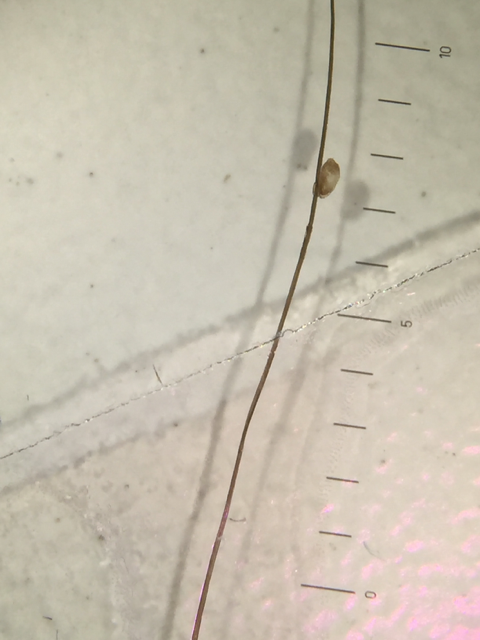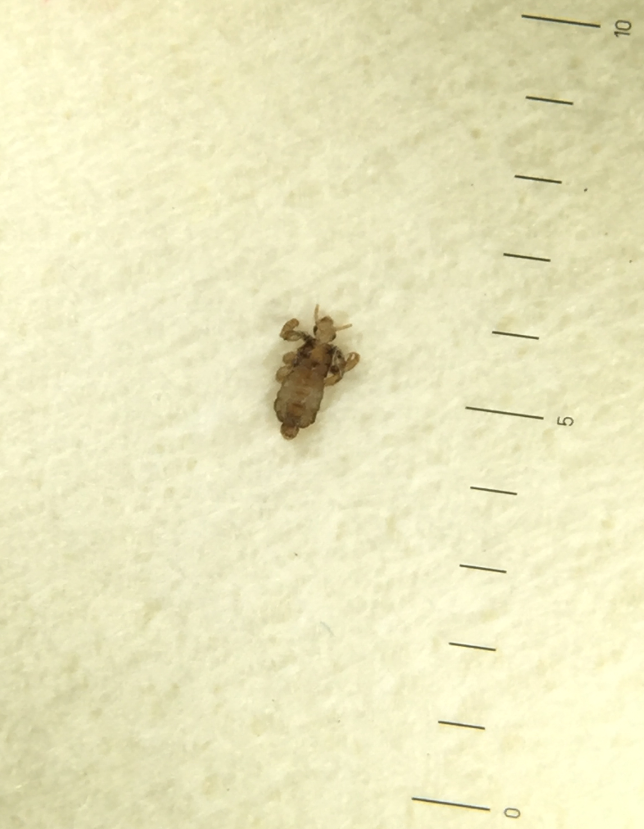Head lice
Pediculus humanus capitis
Head lice are parasitic insects that live close to the human scalp. They feed on blood drawn from the scalp. Their salvia suppresses blood clotting and acts immunological. By moving from hair to hair with the help of their claws they can quickly move from one head to the next.
Females produce about 100 to 300 eggs in their life, even without male fertilization. The eggs are glued near the base of a host hair shaft and the lice nymphs, with about 1-2mm in size, hatch after 7 to 8 days. Head lice become sexually mature after 9 to 12 days and are then about 3 mm long. In best possible conditions head lice have a live cycle of 20-30 days.
Children are more frequently infested than adults and girls more frequently than boys. The frequency of head lice infestation in Central and Northern Europe in childhood is between 2 and 20%, in developing countries however up to 60 %. Head lice infestations are especially common in supervised facilities, kindergartens or schools.

Symptoms
The immune system recognises lice salvia as a foreign substance and reacts with an immune reaction of the delayed type. In an initial infection, symptoms occur after 4 to 6 weeks. You can typically find numerous tiny red, strongly itching papules, especially in places with very high hair density (at the back of the head and above the ears). Scratched areas pose a potential risk for certain viruses (streptococcus, staphylococcus) which are often accompanied by swollen lymph nodes.
Studies have shown that head lice can transmit Rickettsia prowazekii (a bacillus bacterium that is the cause of epidemic typhus) and Bartonella quintana (causative agent of trench fever). These dangerous bacteria are however rather seldom in Europe.
Conventional Diagnosis
Often, the disease is discovered if a louse falls from the head while brushing the hair, if a child is scratching its head or if you see a louse on the head. Generally, a diagnosis is not quite as simple, as in Europe most infected hosts have less than ten lice. Depending on their development stage, head lice are difficult to see, as they are tiny and almost translucent or they have a similar colour as the hair. A clinical examination has to be very accurate and is most promising in the neck. Empty eggshells (nits) can be easily seen as oval white structures; the developable, grey-brown eggs however are rather nondescript. Compared to dandruff, eggs cannot be combed out easily. Lice are can be best detected by wet combing.
A diagnosis can often be made with a microscopic examination of hair or with a direct examination of the scalp with the help of a dermatoscope. Contact your doctor to discuss this type of examination.
Diagnosis of Lice and Nits using a Dermatoscope
The dermatoscope is gaining increasing importance in the diagnosis of parasitic diseases. Since juvenile lice are so tiny, it is difficult to recognize them with the naked eye. Differentiating between resisting dandruff, hair spray residues and eggs is made easier by the precise magnification.
The HEINE diSTANCE working ring is a practical aid for this examination. Used instead of the regular contact plate, it maintains a constant distance from the scalp and allows the areas to be viewed under dermatoscopic illumination and magnification.
Using a dermatoscope also saves time in the daily routine of a busy practice, as you do not have to remove hair and take it to a microscope to examine it. The examination can be directly done on the scalp of the patient.
A non-contact dermatoscope, which offers an illuminated magnification, without having to touch the patient’s skin.
Traditional contact dermatoscopes may also be used. Please do not forget to disinfect the contact plate before and after the examination.

Example videos
Recorded with the HEINE iC1
Treatment and Hygienic Measures
There are several options of treating head lice: The mechanical removal of lice and nits with a head lice comb, the local application of a head lice shampoo or oral medication of substances that head lice ingest when sucking out blood and which then kills them.
Locally effective head louse agents can be classified into chemical and physical effective substances. Chemical substances have toxic effects on the nervous system of the lice. Physical substances such as dimeticone enter the airways of lice, causing death by suffocation. Herbal substances such as coconut oil have similar effects. In general, the treatment has to be repeated after 1-2 weeks.
There are combs with plastic or metal tines. The tines must be parallel to each other and have a distance of no more than 0.2 mm between them. Damp hair treated with vinegar is easier to comb than dry hair.
As a precautionary measure combs, brushes, hair clips and ties can be cleaned in a hot soap solution. Pyjamas, bed sheets, clothes, hats and scarfs should be washed.
If a child attends a communal facility, such as after-school care, kindergarten or school, and is infected with head lice, parents are obliged to inform the communal facility according to the Infection Protection Act.